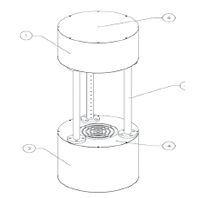Tornado flight simulator prototype for the air combat command nº 3(cacom 3) of the colombian air force
DOI:
https://doi.org/10.18667/cienciaypoderaereo.20Keywords:
Simulator, tornado, monitoring, lab viewAbstract
From the 70’s studies were performed on tornadoes, focused on gathering information to understand the nature of this phenomenon. To get these results, special devices have been built to generate the phenomenon in scale and understand how it occurs and the effects it can generate.
The Air Combat Command 3 (CACOM 3) of the Colombian Air Force (FAC) has taken initiative in this aspect and has been given the task of studying this phenomenon, working on the design of a tornado simulator, based on the existing developed by PHD. Harald Eddens introduced modifications that allow, in addition, generating the phenomenon, measuring and controlling electronic devices through some environmental variables. This device will initiate studies from the Unit to provide support in educating the vulnerable population in terms of understanding how a tornado is produced.
Downloads
References
Alonso Amo, F. (2005). Introducción a la ingeniería de software. Zaragoza, España: Delta.
Bauza G., C. (2009). Animación de tornados en tiempo real mediante motores físicos. Mecánica Computacional Vol XXVIII, pp. 1247 - 1258.
Church, C. (1977). Tornado Vortex Simulation at Purdue University. Bulletin American Meteorological Society, pp.900-908.
https://doi.org/10.1175/1520-0477(1977)058<0900:TVSAPU>2.0.CO;2
Edens, H. (23 de junio de 2003). How to build a tornado machine. Obtenido de http://www.weatherscapes.com, http://www.weatherscapes.com/Techniques/Tornado/tornado.pdf
Haan, F. (2007). Design, construction and performance of a large tornado simulator for wind engineering applications. Engineering Structures 30 (2008), pp.1146-1159.
https://doi.org/10.1016/j.engstruct.2007.07.010
Honeywell. (08 de febrero de 2008). Humidity Sensors HIH-4000 Series. Obtenido de http://sensing.honeywell.com http://sensing.honeywell.com/index.php/ci_id/49922/la_id/1/document/1/re_id/0
Kikitsu, H. S. (2010). Experimental Study on Effects of Tornado on Roofing System in Low-rise Building. Obtenido de http://courses.washington.edu: http://courses.washington.edu/cee517/Kikitsu_UJNR_Workshop2010.pdf
Microchip. (31 de octubre de 2003). PIC16F87XA Data She. Obtenido de http://www.microchip.com http://ww1.microchip.com/downloads/en/DeviceDoc/39582b.pdf
Parras, A.L. (Diciembre de 2006). Estudio sobre la estructura y estabilidad de la interacción de un torbellino libre con una superficie sólida. Obtenido de Universidad de Málaga: http://www.google.com.co/url?sa=t&rct=j&q=&esrc=s&source=web&cd=1&ved=0CFMQFjAA&url=http%3A%2F%2Friuma.uma.es%2Fxmlui%2Fbitstream%2Fhandle%2F10630%2F2626%2F16852059.pdf%3Fsequence%3D1&ei=gT_nT7KZHuGi6gHC4eDhDg&usg=AFQjCNHzLsN0MUB3diEhOvAvrGgvFqRew
Piñeres, E. G. (2010). Acercamiento tecnológico a la aparición de tornados en Barranquilla. Barranquilla: Educosta.
Texas Instruments. (31 de enero de 2000). LM35 Precision Centigrade Temperature Sensors. Obtenido de http://www.ti.com http://www.ti.com/lit/ds/symlink/lm35.pdf
_______________ (31 de enero de 2001). LM741 Operational Amplifier. Obtenido de http://www.ti.com, http://www.ti.com/lit/ds/symlink/lm741.pdf
Trade Leads At. (19 de abril de 2007). Air Treatment & Conditioning. Obtenido de http://www.tradeleads.at, http://www.tradeleads.at/sell/view/115278/Sell-AC-blower.html
Vásquez Herrera, M. (2011). Desarrollo de un Control Electrónico para un Submarino Eléctrico Experimental. Lima, Perú: Pontificia Universidad Católica del Perú.

Downloads
Published
Issue
Section
License
Assignment of Copyrights
Authors assign Ciencia y Poder Aéreo journal the exclusive rights (reproduction, distribution, public communication, and transformation) to exploit and commercialize their work, in whole or in part, in all the formats and modalities of present or future exploitation, in all languages, throughout the life of the work and throughout the world.
All contents published in Ciencia y Poder Aéreo journal are licensed under a Creative Commons Attribution 4.0 International License, whose complete information is available at http://creativecommons.org/licenses/by/4.0/
Under the terms of this license, users are free to download, print, extract, archive, distribute and publicly communicate the content of articles, provided that proper credit is granted to authors and Ciencia y Poder Aéreo, scientific journal of the Graduate School of the Colombian Air Force. Except when otherwise indicated, this site and its contents are licensed under a Creative Commons Attribution 4.0 International License.
For other uses not considered under this license it is required to contact the Director or the Editor of the journal at the e-mail address cienciaypoderaereo1@gmail.com.
The Graduate School of the Colombian Air Force and this publication are not responsible for the concepts expressed in the articles, including the metadata or the affiliation stated by authors. This is the full responsibility of the authors.





















